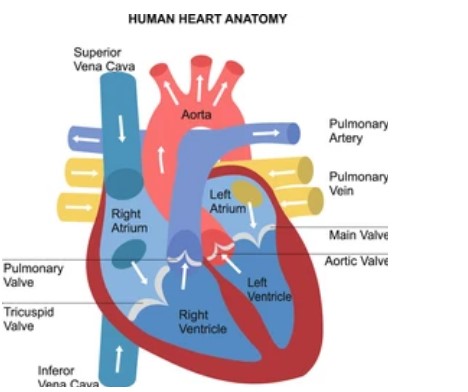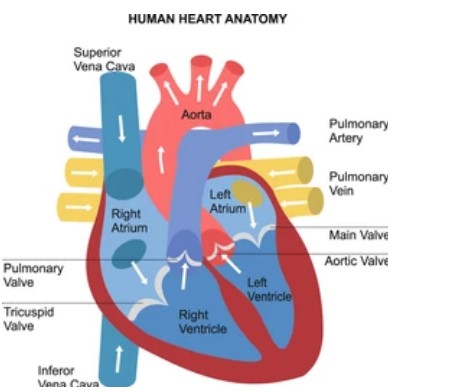Capillaries
The arteries and veins are linked by these very thin blood channels in form of capillaries. The capillaries allow essential elements (nutrients and other substances) to move from the blood into the cells of the body and vice versa. The capillaries facilitate the exchange of nutrients such as food, oxygen, carbon dioxide, etc. between the blood and the cells of the body.
What exactly are the differences between oxygenated and deoxygenated blood?
The blood that contains oxygen is termed oxygenated blood or in other words, the oxygen-rich blood is called oxygenated blood.
The lungs are the source of oxygenated blood, since it is in these organs that oxygen from the surrounding air is combined with the blood before being sent to the heart.
Deoxygenated blood is the blood that is high in carbon dioxide, meaning that tissues and organs have utilized all oxygen. It is produced in all bodily organs except the lungs. The color of oxygenated blood is brilliant red, whereas deoxygenated blood is darker.
The Blood Groups
A person's blood type never changes during the course of their lifetime. According to Karl Landsteiner, human blood may be categorized into four groups: A, B, AB, and O. These are designated by the chemical found in the blood (RBC). Every man has one of these four blood types, which are passed on unchanged from parents to kids.
If a patient has a severe injury and considerable blood loss, it is necessary to transfuse the patient with blood from other individuals. The individual who donates blood is known as the donor, whilst the person who gets blood is known as the receiver.
Blood donation
Donations of blood may be made at numerous hospitals and other government-approved locations. Blood banks are responsible for storing donated blood. Hundreds of people often perish due to a lack of blood. Donating blood hence saves lives.
Why is it necessary to check the blood groups during blood transfusion?
Blood transfusion is the procedure of donating blood from one person to another. Prior to donation, the blood group must be compared since transfusions between blood types of different groups might be harmful. The red blood cells (RBCs) of the patient receiving blood will clump together, which may result in the patient's death.
This affinity between blood groups is known as blood group compatibility.
Heart
The heart is an organ that continually contracts as a pump to transfer blood and other essential substances via a network of blood vessels. Lifelong, the heart continues to move blood without stopping or resting.
Where exactly is the heart located?
The heart is situated somewhat to the left side of the chest cavity. It is situated between the two lungs and is positioned above the diaphragm.
The heart is composed of cardiac muscles, which do not tire and are distinct from the solid muscle.
Our heart is about the same size as our left lung and is surrounded by a protective covering called pericardium fist and internally, the heart is hollow, except for the flow of blood.
Understanding the structure of the heart

The heart is composed of four chambers wherein the top two chambers of the heart are known as atria (singular: atrium), whereas the bottom two chambers are known as ventricles. The left atrium and left ventricle are located on the left side of the heart, whereas the right atrium and right ventricle are located on the right side of the heart.
Separating the atria and ventricles are valves. These are the muscle flaps that allow for unidirectional blood flow. The right side of the heart transports deoxygenated blood, while the left side transports oxygenated blood.
The heart is divided by a barrier known as the septum (from the right side of the heart to the left side). This inhibits oxygenated and deoxygenated blood from merging inside the heart.
Understanding the functioning of the Right and Left Sides of the Heart
The left and right halves of the heart function independently as pumps.
The left side of the heart pushes oxygenated blood throughout the body, while the right side distributes deoxygenated blood to the lungs.
The oxygenated blood must be maintained separately from the deoxygenated blood in order to provide sufficient oxygen to cells for respiration and energy release.
If oxygenated and deoxygenated blood combines, the body's cells wouldn't have sufficient oxygen for respiration, resulting in a decrease in the amount of energy produced by the body.
Heartbeat
Heartbeat refers to the cyclic contraction and relaxation of cardiac muscles that produces a distinctive beating sound.
At rest, the typical heart rate of an adult is between 72 and 80 beats per minute, although it rises during and after physical activity and when a person is enthusiastic.
During a rapid heartbeat, the blood is pushed to the organs more quickly to deliver more oxygen to the body's cells. It facilitates fast respiration and increases energy production. The number of heartbeats per minute is equal to the number of pulses.
Stethoscope
A stethoscope is an instrument that may be used to detect the heartbeat. Doctors use it to magnify the sound of the heart to hear the beats of the patients. The stethoscope comprises the following components.
⦁ A chest component that carries the diaphragm
⦁ Dual earpieces
⦁ A tube connecting the two components
⦁ Using a stethoscope, physicians may determine the status of the heart by listening to the heart's sounds.
How to construct your own stethoscope?
You may create a stethoscope model on your own. Take a tiny funnel with a diameter of 6-7cm and attach a rubber tube to the funnel's stem. Stretch a rubber sheet across the funnel's opening.
Using a rubber band, secure it securely. Insert the tube's open end into one of your ears. Now, position the funnel's mouth on your chest near your heart.
Carefully listen to the hammering sound, which is the sound of the heartbeat. Count the number of heartbeats per minute of the individual.
To know more about blood, the heart, and the flow of blood in the heart, check out our videos.


